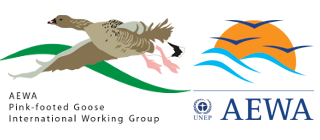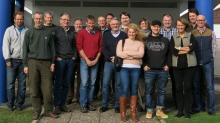Current Size: 76%
Norwegian and Danish stakeholders share their experiences about pink-footed goose management
A group of scientists, managers and stakeholders from Norway recently gathered in West-Jutland, Denmark to exchange experiences with their Danish counterparts about pink-footed goose hunting practices and management. As part of the International Species Management Plan for the Svalbard pink-footed goose, Norway and Denmark have a special responsibility regarding the sustainable harvest of the population. An ongoing research project in Norway, GOOSEHUNT, has a reference group with relevant stakeholders, and this year’s annual meeting was held in Denmark to share international experiences and for key stakeholders to learn from each other.
Two Norwegian research projects, one focussing on the hunting (GOOSEHUNT) and one on the agricultural conflicts in spring (MIGRAPOP), have the same reference group with representatives from key stakeholder groups. The reference group is composed of delegates from the environmental and agricultural authorities, both at the regional and local levels, as well as from the regional ornithological, hunters, farmers and landowners associations. The reference group, along with scientists involved in the projects, gathered for an annual meeting in Ringkøbing, West-Jutland, between the 25-27 October. Here the group was able to discuss and evaluate these projects, as well as share their experiences with Danish counterparts involved in a similar project, “Forbedret gåsejagt – Improved Goose Hunting”, to improve the local organization of hunting in West-Jutland.
The first day focused on the Norwegian projects, where the research activity in Norway was presented and discussed. On day two, representatives from the Danish Nature Agency, the Danish Hunters’ Association and scientists from Aarhus University attended. In the morning there were a series of presentations to share experiences about hunting practices, goose management and hunting research projects in Denmark. This was then followed by an afternoon tour visiting various hunting areas that are part of the Improved Goose Hunting project, around Ringkøbing Fjord. During their remaining time in Denmark, the Norwegian reference group visited farmland which had experienced crop damage and intensive grazing by pink-footed geese, as well as various habitat restoration initiatives in West Jutland. Two Norwegian hunters also stayed an extra couple of days to participate in a goose hunt hosted by local Danish hunters.
Over the course of the visit both Norwegian and Danish delegates learnt a great deal, with several issues being highlight:
- The need for joint action by both Norwegian and Danish hunters to reduce the crippling of geese.
- Grazing pressure by pink-footed geese in Denmark is relatively stable but the rise of the barnacle goose population was considered a cause for concern.
- Not all habitat restoration projects may be beneficial for geese if they impact key feeding areas.
Furthermore, it was recognised that although there are many similarities in hunting practices between the two countries, there were some subtle differences. Denmark has a longer goose hunting tradition with more established attitudes, practices and access to hunting areas. Whilst in Norway goose hunting is in its infancy, with a more “open access” attitude that is attractive to new goose hunting recruits. Overall, the meeting was successful in building new relationships between key stakeholders in Norway and Denmark. It reinforced that cooperation and sharing experiences is necessary and vital, in order to successfully implement the International Species Management plan.
Ingunn M. Tombre
Senior researcher at NINA
Project leader
GOOSEHUNT & MIGRAPOP
Date added: 04.12.2013















